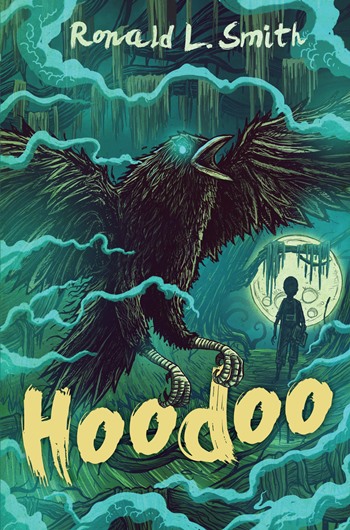
Hoodoo
by Ronald Smith
Houghton Mifflin Harcourt, 2015
224 Pages
Middle Grade (8-12 and up)


A dark stranger comes for a young boy in Alabama in the 1930s. The main character is named Hoodoo because of the unusual heart-shaped birthmark he bears just below his left eye. (The term Hoodoo is not to be confused with Voodoo, the religion that evolved from African spiritual beliefs. Hoodoo is a specific type of traditional American folk magic.)
Hoodoo Hatcher was raised by his grandmother, who he called Mama Frances. His Grandpa (Pa Manuel) didn’t live with her, but he came around when things needed doing… even if he might be a little worried about being hexed when he did. Hoodoo’s father was out of the picture, as was his mother who died when he was born. In fact, unraveling the mysterious past of his family pulls us deeper into the story as he is motivated to help his family and a girl he cares for, named Bunny, when a creepy outsider comes to town asking for a special hoodoo charm called Mandragora.
A hand, followed by a long arm, shot right up out of the dirt. Crooked, black fingers grabbed at the empty air. And then, with a sound like an ax chopping through wood, a dead man rose up out of his pine box. He had on a long cloak and a wide-brimmed black hat. His eyes glowed red. He was coming for me. “Mandragore,” he said, as slow as molasses. “The one that did the deed.”
After horrifying visions begin in his dreams, Hoodoo goes to see the fortune-teller from the county fair, but is given only a cryptic clue to who this guy is and what he wants. He learns that the evil figure is a demon in human form come to collect on the debts of his father. It is finally revealed that Hoodoo’s father had died on the gallows, convicted of murder, and had made a “deal with the devil” at the end. But it backfired.
Beware! He who holds the hand of glory may use the dead man’s fingers as candlewicks, which cast an unholy light, by which the dead can be called from the grave to do the owner’s ghastly work, spreading death and destruction in his name.
Hoodoo steals a book from the fortune-teller. Turns out he’s gonna need a lot more protection for his troubles. Hoodoo’s hand starts to get hot, real hot, and when he loses his temper, he gains amazing strength in that hand. It’s his father’s hand. The hand that did the deed. The hand the dark stranger is coming for.
Hoodoo explores an overgrown meeting house and discovers a dusty tome beneath the floorboards, he goes soul-traveling and talks to his father, which leaves him with even more questions, and he learns that conjuring is in his blood. He tries his own hand at magic. But when the demon comes for its due and puts the entire town under a spell, will a few magic words be enough to defeat him?
The story gives insight to the life a black kid might have led back in the 30s, worried about being swindled by the local carnies, bullied by a pair of local boys bigger than him, and loving the food he grew up with, like catfish, grits, and chitlins. Racism is explored deftly, exemplifying itself in the matter-of-fact description of Hoodoo’s daily life. Smith’s depiction of a hidden South is woven so skillfully in fact, that I desperately want to learn more about Hoodoo’s world, to taste it more deeply both in its triumphs and its dark corners.
I admit I was first attracted to the book because of the cool cover art, but I am so glad I dove into this world of secret societies, grimoires and curses. It’s really a charm. I’ll be anxiously looking for more from this author! (His second novel The Mesmerist is due out in 2016!)
“Aha,” she croaked, seeing my face. “Ain’t nothing to be afraid of. This here chicken foot will get rid of the bad juju left from that demon.” I didn’t know what bad juju was, but figured it wasn’t good if it had to be gotten rid of.
